“Institutions change, in a slow and tedious way, but it happens”. Interviewing Philipp Schramm and Katharina Fink from Iwalewahaus
“Iwalewahaus” is an institution in Bayreuth, Germany. It was created by Ulli Beier. The pronunciation of the word in German is “Iva-leva Haus” because the sound “w” has no correspondence in German. The term “Iwalewahaus” is originally from the Yoruba language and is pronounced “Iwa lewa” in this language. “Iwalewahaus” means “character is beauty”.
About “Iwalewahaus”, a brief story
The “Iwalewahaus” was officially opened on the 27th of November 1981 as a support for the Africa focus of the University of Bayreuth. The initial idea of this was of introducing to broader public African arts and cultures. The founder of the “Iwalewahaus”, from 1981 to 1985, was Ulli Beier (1922–2011). Beier was a noted connoisseur of Nigeria’s arts and cultures and when he moved to Papua New Guinea in 1985, Ronald Ruprecht became temporarily the director of the house. From 1989 to 1996 the house was again under the aegis of Ulli Beier.
From 1997 to 2001, “Iwalewahaus” was directed by Till Förster, when Förster moved to the University of Basel, Tobias Wendl became Iwalwahaus’ new director. After Wendl was offered a chair at the Free University of Berlin “Iwalewahaus” has been directed by Ulf Vierke and Nadine Siegert as Deputy Director since 2010.
With the exhibitions, the academic research, lecturers, and with the diversity of African art collections and archives as well as providing residencies for artists, current developments in contemporary African and Diaspora culture are presented and refined together with different artists and institutions. The house provides space for lectures, conferences, concerts, film screenings, readings. It is a very dynamic forum for artists, researchers, students of African studies, and the public.
“Iwalewahaus”: “Character is beauty” - past, present, and future
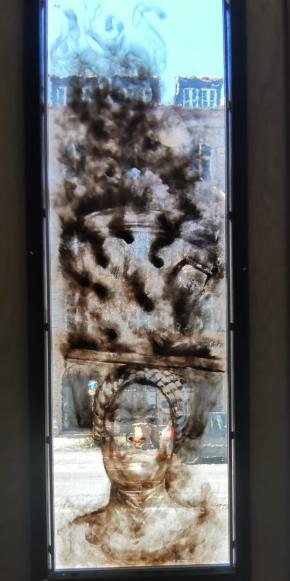 'The firebringer' by diane victorWe started this news report with a guided tour made by Dr. Katharina Fink. We visited the different floors of “Iwalewahaus”, and it was explained what the function of each one of the three floors was. The ground floor dive space for events, such as cinema, conferences, workshops, festivals. The first floor is the exhibition space. The second floor is the office’s floor. The third floor is the space for art collections, which currently counts on more than 10.000 African art collections. The floor on the art exhibition space has a guided system for blind people, but in the future, it is planned to build this throughout all the building.
'The firebringer' by diane victorWe started this news report with a guided tour made by Dr. Katharina Fink. We visited the different floors of “Iwalewahaus”, and it was explained what the function of each one of the three floors was. The ground floor dive space for events, such as cinema, conferences, workshops, festivals. The first floor is the exhibition space. The second floor is the office’s floor. The third floor is the space for art collections, which currently counts on more than 10.000 African art collections. The floor on the art exhibition space has a guided system for blind people, but in the future, it is planned to build this throughout all the building.
The building that gives space to the museum was previously meant to be a bank and is more than 100 years old. Currently, it is still possible to find some traces of it in some parts of the “Iwalewahaus”, which make part of the building’s history.
On the floor before the events’ floor, there is a piece of art made by candle smoke on the glass: “The Firebringer” by Diane Victor. How is it possible for someone to create a piece of art with candle smoke? The topic of this piece is related to smoke and war. Female workers that offer lunch for working people, which they heat with fire basis and charcoal. The symbolism of the women’s work to society.
Interviewing Dr. Philipp Schramm and Dr. Katharina Fink
What is your role at “Iwalewahaus”?
PS: My task is to be a curator for the exhibitions, especially for the regards of inclusion to offer widespread forms of information to as many people as possible, in different languages. I also make part of the educational area of “Iwalewahaus”. I give lectures and seminars to students.
Why was it decided to transform what would be a bank into a building with African arts?
PS: The end of the First World War in 1918 also meant the end of the Bavarian kingdom. There was a crucial time change for Europe with the appearance of democracies and republics. Bavaria became a Freistadt, a free state with a republic as well. The constructed bank was meant to be a kingdom’s bank. If there was no kingdom anymore, the bank itself would no longer make sense and there was no money to keep going with its construction. The building remained until it was turned into a museum: The “Iwalewahaus”. “Iwalewa” is a Yoruba expression that means “character is beauty”. This museum is in the heart of Bayreuth’s city, right in the city center and it is very close to the famous “Operahaus”. From the outside of the Iwalewahaus building, we already face a nostalgic feeling of something with a deep meaning and history, due to the timeless feeling we have just for looking at the building.
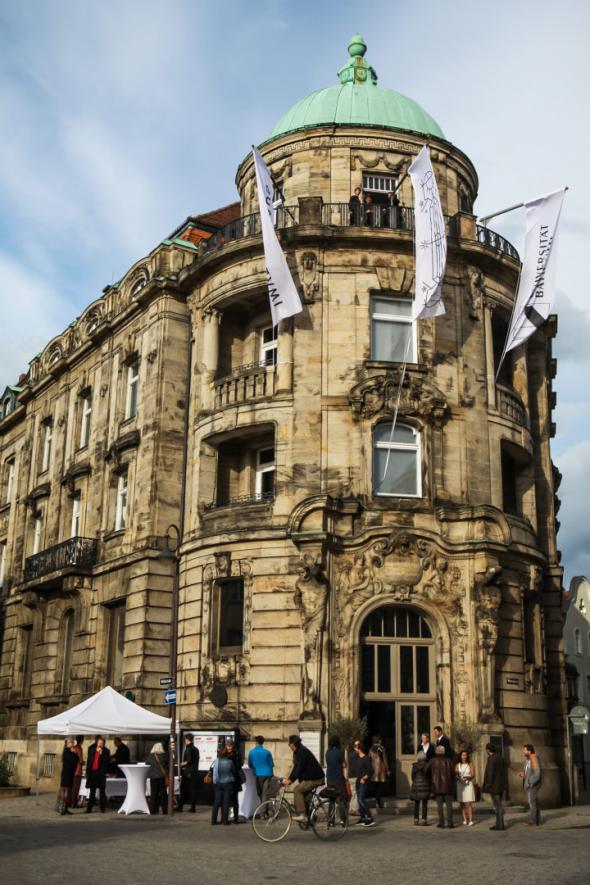
At the back of “Iwalewahaus”, we can find the mural in a layout that gives us a special atmosphere of creation, art, innovation, beauty, and character. This was made by Obou Gbais in July of 2021. The painting itself only took a couple of days and was made by the artist himself. Obou Gbais uses the mask as an element of his own artistic identity.
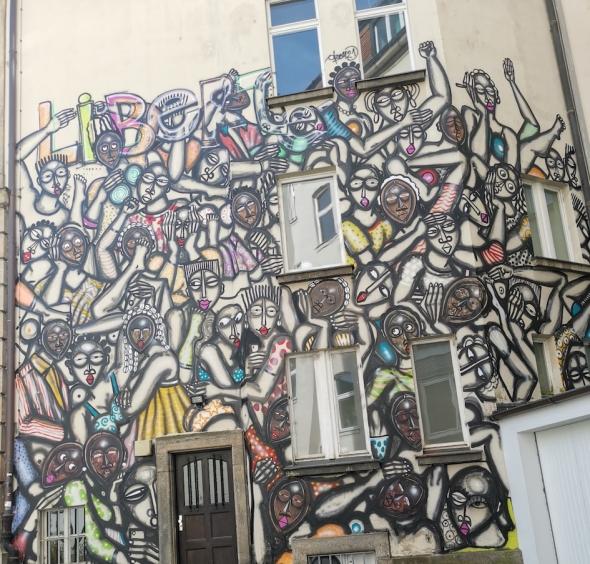 Obou Gbais art
Obou Gbais art
The times of the last two years have been very difficult for artists and with this, the relationship between those artists and “Iwalewahaus” became even more important. Working in partnership implies giving space and voice to the other who is different and has something to be expressed. In this case, through pieces of art.
“Iwalewahaus” has many programs and projects with resident artists that stay there for some time and create unique art pieces. This is the case of Yassine Balzioui. He is one of the most important contemporary artists from the African continent. He was in with us in 2017 and he wanted to try new things to create art. According to him, art can come from all places, we just need to go and try. In his painting, we can see different symbols with a critical meaning, which may differ depending on the observer’s perspective. There are essentially critics about white institutions and African arts.
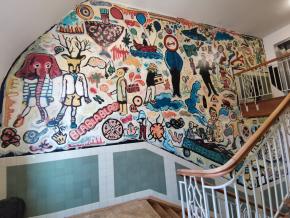 Yassine Balzioui painting
Yassine Balzioui painting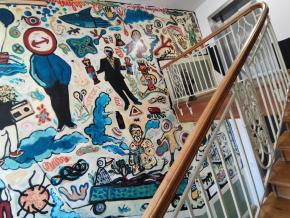
Those resident artists have atelier spaces in “Iwalewahaus” where they can stay for an agreed time and create their pieces of art. How can artists and “Iwalewahaus” work together to find new forms to celebrate humans, differences, diversity, similarities?
PS: Artists such as Kelebogile Ntladi, Breeze Yoko, Sam Hopkins, Diane Victor, Cuche Okeke, Yassine Balbzioui, Ndidi Dike, Obou Gbais, worked with “Iwalewahaus”. Relation and networking with local institutions from different countries increase the museum internationalization and connection with several places in Africa and other continents. The education program at the institution has the aim of creating a space of inclusion and anti-racism for everyone.
“Iwalewahaus” has a field of studies relayed with curatorial studies, which is related to expositions, its history, how to make it, and its relationship with power. “Iwalewahaus” is an artistic branch of the University of Bayreuth, and it is the greatest evidence of African studies in the city of Bayreuth.
Each one of the insects was swimming in the water’s pool, and Sam Hopkins decided to create that piece, the artist had the idea that the archive should be open and more accessible to spread information to more people.
“Iwalewahaus” has a big textile collection, it was made, in collaboration with Bayreuth University and a local company, a remix of patterns and colors of some art collections.
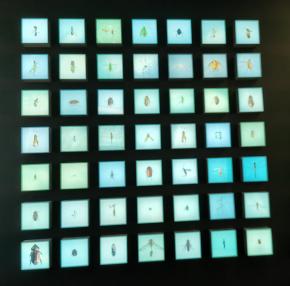 Sam Hopkins insects’ things
Sam Hopkins insects’ things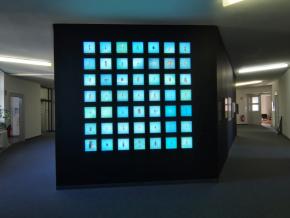
Which arts are most relevant to the museum? Why?
PS: I wouldn’t most relevant. There are different kinds of art with different meanings and importance. We have space for art collections from the African continent, which is our focus and main type of art, meaning that we have art collections from other parts of the world as well. There are different ways of thinking about art, of representing it. We sometimes have performances, music. It was already from the very beginning meant as a place for the creation of vivid art, so “Iwalewahaus” is not just about collections in a typical way. It is essentially a place of exchange and communication in art. This is still one of the most important features.
Meaning that all the art at “Iwalewahaus” has the same impact, the same relevance, there is no such thing as a more important artist or a more relevant piece of art…
PS: What can be the most relevant might be related with what is in exposition at the musem, or what might be created by a resident artist in a specific moment or period of time, the focus of our attention should be on something concrete, and as curators, we always care about those artists who are in place at the moment.
So, for example, the artists who stay here and create something for particular expositions are those who are the most relevant, but mainly during the creation and exposition moment, and then another one takes part.
What is the art exhibition “The not yet” collection about?
PS: Different artists took place on this current one. The “not yet equal” is dedicated to the females’ artists in our collections. The “not yet shared”, “not yet joyful”, “not yet inclusive”, “not yet seen”, “not yet caring”, were made by several curators, and each one of them has a specific and important part on the collection as a whole.
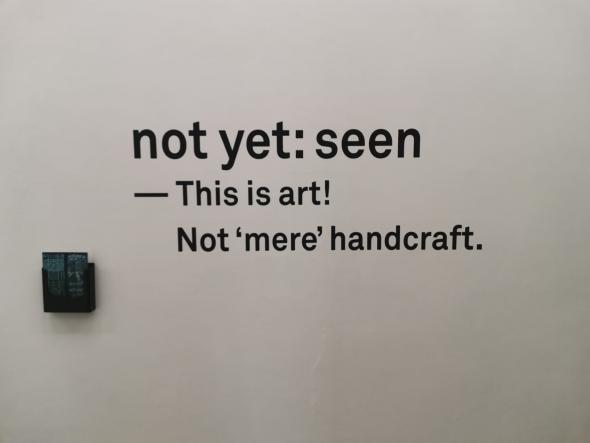
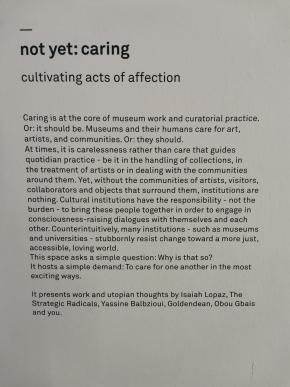
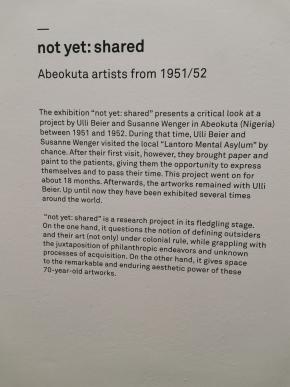
The museum has now more than 10.000 pieces of art. From which African countries are the art pieces you have?
PS: Originally, Ulli Beier started working in Nigeria, but his attention was on countries like Sudan, Ghana, South Africa, Mozambique, Ethiopia. He traveled a lot and had contacts in different places. But still, we have artists from many other countries as well, like the United States and Australia. “Iwalewahaus” in an international art museum, therefore English is the “lingua franca” for meetings and every kind of event we may have.
Are those art pieces donations made by the artists, or are they something that you find online, or collaboration made by the museum and the artists?
PS: We have some pieces that were donated by a circle of friends of the “Iwalewahaus”: “Freundeskreis”. It is a community of friends that are generous and sometimes help us to achieve goals or purchase artworks we couldn’t afford with our own budget because it is quite small. We have a budget for art acquisition and these pieces can also be achieved on the online market as well, or when some of us are traveling and find something. In general, the artworks we have here are mainly the results of artists in resident projects.
Why is the “Iwalewahaus” so important to Bayreuth, to Germany, and to Europe in general?
PS: I really hope it is important to Germany, and to Europe. I think “Iwalewahaus” is important to Bayreuth because its idea remains in connection with the spirit of the European Union, with the spirit of an open society, the idea of democracy. This was always what Ulli Beier intended. He was a traveling man the whole time of his life. He first went from Prussia to England or London, then he moved from London to Nigeria, and then to other countries. Ulli Beier’s life was a big journey. Somehow, the “Iwalewahaus” should be a character of a big boat traveling on a big journey as well. Therefore, we should share together this important journey to experience new horizons.
Bavaria is a very conservative state and “Iwalewahaus” brings this idea of diversity and openness to other perspectives, communities, and people. In the heart of a very conservative place, we find this museum. In a general way, when we think about Bayreuth, we don’t necessarily think about “Iwalewahaus”. Do you believe that resident people have been respecting Ulli Beier’s main idea for “Iwalewahaus”?
PS: You have pointed to the culture of the city, to the traditional way of living here contrasting with the idea of “Iwalewahaus”. Since the foundation of this place in 1981, a lot of people never exactly noticed the existence of the institute. They might know that somethings happen here and that’s all. I would say that the group around Ulli and Georgina Beier were and weren’t exclusive, at the same time. Times pass and people’s minds change, and I can say surely that Bayreuth of the 2020s is not the one of 1981. People now are more open-minded.
We sometimes face some challenges related to old ways of thinking, but this happens everywhere. Bayreuth is a small city and if you want to have an exciting atmosphere or a certain feeling of vibration in the air, perhaps bigger cities would be a better choice. There are other art spots in Germany and in Europe. Although, a certain feeling and specific atmosphere allow us to feel and create different and special experiences. For example, in terms of inclusion, events, or the collaboration between “Iwalewahaus” and “Richard Wagner Museum”. We are already facing wonderful and special results happening. If you have the chance to have a testimony of those events, it may be for sure something you won’t forget.
From 1981 to our current reality, did “Iwalewahaus” already face problems with its recognition?
I’m not sure, but I don’t think so. Essentially because “Iwalewahaus” is part of the University, and it is related to research.
Due to debates with some friends, I have realized the relevance of having “Iwalewahaus” in the middle of Bayreuth. It might be seen as a reminder to make people think about diversity. Character is beauty, as the difference is beauty…
PS: That is a very good hint. Tension is what we also need to create. If there is tension between conservative parts and progressive parts, then there will be discussions and debates. We, at “Iwalewahaus”, always try to find a common base.
Maybe someday Bayreuth will be known for the “Iwalewahaus”.
PS: I hope so. That’s what we are intending to do.
Dr. Katharina Fink joins the conversation and interview. She is deputy head of “Iwalewahaus” for coordinating programs, and teaching, also making part of the department of inclusion.
Is there any relationship between Germany and African Art?
PS: There are many. Germany and African arts in general. Historically, politicly, economically, so many different aspects we could focus on. “Iwalewahaus” history has something special. For example, most of the pieces of art in the collection were purchased and somehow collected by Ulli Beier. These discussions about the origins of art are not politically confronting here in “Iwalewahaus”.
KF: We can choose where the work is from and which kind of art contact has led to the creation of artworks, but at the same, it is not so easy and clearcut related to the origins of those who might create African art. It is naïve to think that there are no patterns of dependency or balances. We, at “Iwalewahaus”, have bigger programs. Beyond the question of illegal acquisitions of art, we should go back to where the art is from, relating this with who has access to those pieces. What is the point of people from Nigeria, for example, traveling to Germany to see original Nigerian pieces of art? It is mostly a matter of accessibility, and it is important to think about this as well. Original artworks should be able to travel, and museums can have copies with them. There are many ways of doing collecting collectively. This is something we need to think about in a deeper way. No piece of art belongs specifically to a particular institution. Art is collective property. We need to decentralize the possession of artworks. I don’t really know whether it is useful to think about the relation between Africa and Germany in those terms.
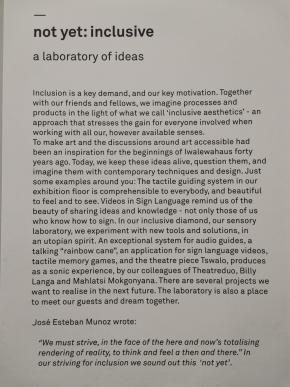 In São Tomé and Príncipe, for example, there is no such a thing as European art museums, but it is very common in different places, not only in Europe, to have African museums. It is good to think about other people and communities, but it is odd to expose this in museums. At first, I questioned why?
In São Tomé and Príncipe, for example, there is no such a thing as European art museums, but it is very common in different places, not only in Europe, to have African museums. It is good to think about other people and communities, but it is odd to expose this in museums. At first, I questioned why?
KF: People are just curious, and it is good to have things from other places, integrating them. Migration and movement are enriching, stimulating, and very important. I really like to think that life is not about national culture. I agree that is also related to a question of power and whiteness. If we think deeply about it, who of our colleagues with a fixed position here is black? None. This is a dimension we seriously must face and want to change. We can’t talk about decolonization and ignore those situations. That is one of the reasons why we decided to do the “not yet” exhibition. It is not yet ok. There is a lot of work to be done here.
Why do particular artists and not others work with you?
KF: Our amazing colleague Leena Naumann, she can answer that.
LN: Some artists approach us because “Iwalewahaus” is a name to them, maybe because of common aspects related to history. My personal experience showed me that artists who already worked with us generally return, so we do different artworks with the same artists. We have a strong work relationship, and, in a way, it turns into a friendship that is developing with time. We have currently, at least five artists who are part of the team. We worked with them in good and bad times. History in a way is also a responsibility due to connections that were constructed with time. We have the same aim and the feeling that both sides can benefit from a collaboration.
KF: Working in relation is exactly what we do here.
Which steps “Iwalewahaus” has already taken on decolonization’s debate?
KF: I think we always have the responsibility of looking into the ghosts of these colonial dreams and taking the ideas further. For example, we must rethink what are artwork features and what exactly defines them? Institutions change, in a slow and tedious way, but it happens. If we also think about the thesis and how it is configurated, how free can we be about the aesthetic part of it? Now we can offer “decolonize art studies” as a course. All the reconfigurations are a very long process to be achieved. A very important thing I would like to highlight is that where you are you must do your work and contribution. We should try to influence others with our work, inspiring them and trying to change what we know is wrong. Working within a community where the institution is located is very important, for me, and we are glad that our students understand this commitment. Now, for example, we have students that offer decolonial guided city tours. Currently, decolonization is a password. Everyone is using that, many conferences have that, but again this is a very slow, tedious kind of work that needs more time to be done.
Are there any protocols between “Iwalewahaus” and the artists? Something like a code, a previous agreement, or a contract?
KF: It depends on the project. We have a code of ethics that was made with the staff members and our students that everybody must obey. Basically, there are some values and conducts of how we want to work together that we set out to ourselves, and they also apply to the resident or visiting artists. All the projects and processes are very different. Every project is unique, and some don’t have a previous protocol. We craft the conditions of work around the specificity of the project. It is important to be clear and transparent with our partners in a reliable way for both sides.
How is the relationship between art and theory? How does it work?
KF: There are many answers for that. Personally, I think that working aesthetically or artistically is also a way of making theory. Through the material, there is memory construction. The theory is made by ways of expressing what we see or don’t see or think about the society
When an artist has an idea, it may be very difficult to put it in a practical way that works that people will recognize the idea of the piece of art…
PS: Aesthetics is a very profound topic. If you are in contact with art like looking at pictures, listening to some music, reading a book… If we are talking about theory, aesthetics we can dig into a very deep and complex discussion that enriches the profile of artworks.
I remember talking with you about the importance of perspectives. What may be art for someone might not be to another person…
PS: Yeah, it was about the question of the end of art… The idea of what art can actually be or not. To many people in Bayreuth what “Iwalewahaus” is doing might not be art, and it is wonderful to have some questions and debates about the definition of what art is. In a way, it is not just theory, it is our daily life choices and options that we must defend.
Is there a relationship between Richard Wagner Museum and “Iwalewahaus”?
KF: Yes. It wasn’t something we planned to, but we have a good relationship with Richard Wagner Museum. We have made some exhibitions together with them during the festivals time, talking about Wagnerian ideas (“Gesamtkunstwerk”) and Afrofuturism. We love to bring things that were treated differently together in the context of debate and exchange. What “Iwalewahaus” and Richard Wagner Museum have been going together is unexpected and nice. We have done an exhibition about the world and theater. We did an Opera together too. They are open to cooperate and work with us. It is a heavy heritage, for sure. We are dealing with a heritage of antisemitism, racism. When we say Afrofuturism, we are talking about futures, with protocols and things are done in a careful way. We don’t intend to expose people to racist theory pretending everything is solved and ok. In small places like Bayreuth, we need to try to work together with kindness.
Perhaps all the collaboration depends on those who are in charge. Now it may be easy to work with them, but in 10 years, with other staff, this reality might change.
KF: Yes, but I also think that we shape institutions’ cultures and what it is possible and not possible. Institutions grow and so do audiences. You can never go beyond what has already been done.
It is not only about new perspectives and ideas but is also about thinking about the past in a different way, with critical knowledge. The past is the past and we cannot change it, but we can do things differently from now on in our reality…
PS: I think that decolonizing the “Iwalewahaus” is a very important task. Questions of equality, accessibility, making of the artworks… We don’t have answers to all of them, but we are working to find solutions. I can’t say that we will always work with the same rhythm and the Pandemic is evidence of that. For some time, the atmosphere at “Iwalewahaus” was silent and that is not the task the house is meant for. We are a place for debates, discussions, communications, inclusion. We are not static.
“Iwalewahaus” is an open and safe space for differences.
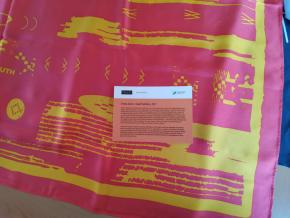 Cloths
Cloths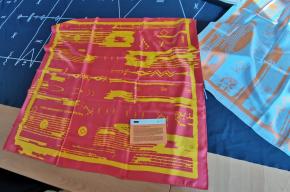
References
Bavaria: Bavaria - Wikipedia, the free encyclopedia
Breeze Yoko: Breeze Yoko (@breezeyoko)
Cuche Okeke: Uche Okeke - Wikipedia
Diane Victor: Diane Victor - Wikipedia
Dr. Katharina Fink: Dr Katharina Fink (uni-bayreuth.de)
Gesamtkunstwerk: gesamtkunstwerk - wikipedia
“iwalewahaus” - history and<br />identity (uni-bayreuth.de)
Kelebogile Ntladi: IWALEWAHAUS - Kelebogile Ntladi (uni-bayreuth.de)
Ndidi Dike: Ndidi Dike - Wikipedia
Obou Gbais: Obou Gbais - 9 Artworks, Bio & Shows on Artsy
Philipp Schramm: Team (uni-bayreuth.de)
Richard wagner: richard wagner - wikipedia, the free encyclopedia
Sam Hopkins: index (samuelbhopkins.com)
Ulli Beier: Ulli Beier - Wikipedia
Yassine Balbzioui: Yassine Balbzioui - Overview | Kristin Hjellegjerde